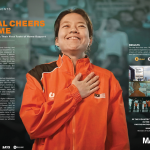By The Malketeer
The Future of Malaysian Advertising is Cross-Screen
In Malaysia, where digital platforms have long dominated advertising strategies, television—both traditional and Connected TV (CTV)—is proving it still holds significant sway.
Recently, we explored in an article in The Marketing Magazine, the data-driven insights that are prompting advertisers to reconsider their all-in approach to digital, highlighting the high view-through rates (VTR) and unique engagement opportunities that television presents (Source: Mindshare).
This article delves deeper into how advertisers are leveraging both traditional TV and CTV to create a balanced media mix that maximises return on investment (ROI).
A Balanced Approach to Media Planning
Advertisers are now faced with a fragmented media environment that challenges them to capture audience attention across multiple screens.
While digital remains a powerful tool for reaching audiences, there is a growing recognition that traditional and Connected TV each bring unique strengths to the table.
There’s a tendency to think in binaries—either digital or traditional.
But, in reality, what we’re seeing is that each platform has a distinct role in delivering the full spectrum of audience engagement.
Traditional TV, for instance, still offers unparalleled reach and the ability to build broad brand awareness, while CTV allows for more targeted, data-driven approaches.
Reevaluating Traditional TV in a Digital World
Recent data suggests that while digital ad spending in Malaysia has surged dramatically, with an increase of 259% over the past five years, there are concerns about its efficiency when not balanced with traditional media channels (Source Mindshare).
Many advertisers argue that a diversified approach might yield better results.
The resurgence of traditional TV alongside CTV suggests a complex and evolving media landscape that calls for a balanced ecosystem rather than a total domination by any single medium.
Indeed, the numbers tell a compelling story.
The high VTR associated with traditional TV, where a view is counted only after a 60-second completion, far outstrips that of digital platforms, which often count a view after just a few seconds.
This metric alone indicates that TV might offer a more meaningful engagement, particularly for brands focused on deep audience connection rather than just broad reach.
The Emerging Power of Connected TV
At the same time, Connected TV is rapidly gaining traction as a critical advertising platform.
As Matthew Ho, Managing Director of Astro Media Solutions, shares insights into this trend: “Cross-screening planning is now the norm in this post-digital era, yet globally, measurement remains fragmented, with platforms still often measured in silos.
In Malaysia, Astro led the way as one of the first to launch Addressable Advertising in Southeast Asia, the next-level in TV Advertising with the ability to deliver ad opportunities with relevant messaging in a connected TV environment.”
“Our partnership with Kantar Media to launch the region’s first Unified Audience Measurement (UAM) system connects and measures audience data across TV, On Demand, and Astro GO, paving the way for more robust across-platform measurement with further enhancements in the roadmap.”
This dual strength is why CTV’s penetration in Malaysia has reached 41%, as platforms like LG and Samsung innovate with ad placements that range from immersive 3D effects to behaviour-based targeting.
According to a Mediaocean report, CTV has now become a leading trend for marketers globally, driven by its ability to combine the reach of traditional TV with the engagement metrics of digital media.
Case in Point: Sunsilk’s ‘Rambut Tetap Boom!’ Success with TV and CTV
A compelling campaign exemplifies the synergy of cross-screen planning, moving beyond impressions to foster meaningful engagement.
By embedding dramatic hair moments within pivotal scenes of Astro’s highly-watched Malay dramas, starring popular celebrities like Anna Jobling, Janna Nick, and Nad Zainal, Sunsilk seamlessly integrated content that resonates deeply with the Gen Z audience.
Core Performance Metrics :
- Reach – 5,354,247
- Extended Reach via Astro Addressable Advertising (targeting Malay & Fashion segments) – 673,652 (+24%)
- Video Views – 1,087,927
- Engagements – 441,762
Capitalising on the emotional investment viewers have in the show, Sunsilk became a part of the audience’s experience.
Through Astro’s extensive transmedia network, the campaign effectively leveraged local content, talent and targeted strategies to enhance engagement across TV and CTV, ensuring visibility and relatability.
This strategy offers a replicable model for other brands looking to increase engagement through TV advertising by leveraging local content, talent and addressable solutions.
New Tools, New Opportunities
In Malaysia, new tools like GroupM’s enhanced “mScreen” are enabling advertisers to gain deeper insights into cross-platform audience behaviour.
With features such as audience de-duplication and platform-level reach curves, “mScreen” has helped to redefine how media planners allocate their budgets across different screens.
For many brands, these tools are revealing that a more substantial investment in TV could significantly boost media effectiveness.
Tools that provide unified measurement are game-changers for marketers looking to maximise ROI.
They offer a way to accurately assess how audiences interact with content across different devices, helping advertisers make more informed decisions about where to spend their money.
The Road Ahead: Integrating TV and Digital for Maximum Impact
For Malaysian advertisers, the challenge now is to integrate these diverse channels into a cohesive strategy.
The key is not to choose between traditional and digital but to understand the unique value each brings to the table and how they can complement each other.
Marketers should consider unified audience targeting, cross-platform retargeting, and integrated measurement techniques.
These strategies allow for a more holistic view of the media landscape and help optimise both reach and engagement.
The Future of Advertising is Cross-Screen
As the Malaysian media landscape continues to evolve, the line between traditional and digital is becoming increasingly blurred.
“With digital and streaming transforming viewing habits, we’ve seen a 135% increase in on-demand streaming over the past five years. Consumers today switch between screens, embracing time-shifted viewing.
At Astro, our Addressable TV – an audience-centric solution enables advertisers to tap into this trend, combining the precision of digital targeting capabilities with TV’s unparalleled power to persuade. This approach not only ensures we reach the right audience but also drives better relevancy for campaigns.
By layering addressable CTV with traditional TV, we’ve seen audience performance improve by 4% to 16%, with brand lift studies showing an average 20 percentage point increase in consideration scores,”concludes Matthew Ho.
The opportunity for advertisers lies in understanding this blend and leveraging it to its fullest potential.
By balancing the strengths of traditional TV and CTV, and by incorporating robust metrics like VTR and cross-platform reach, marketers can navigate the complexities of the multiscreen world and drive meaningful results.
In this new era, it’s clear that the future of advertising in Malaysia isn’t just digital—it’s cross-screen.
MARKETING Magazine is not responsible for the content of external sites.











